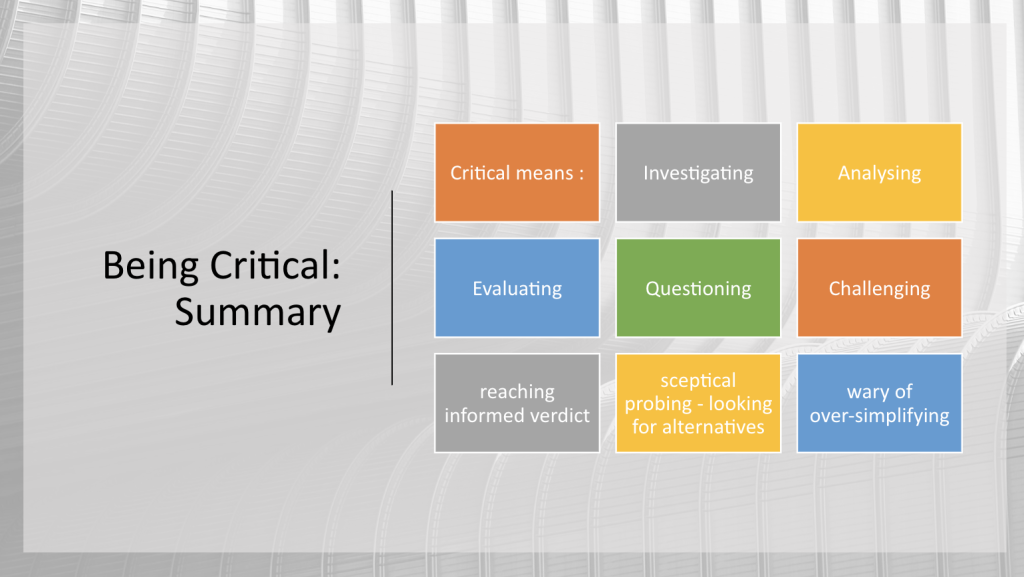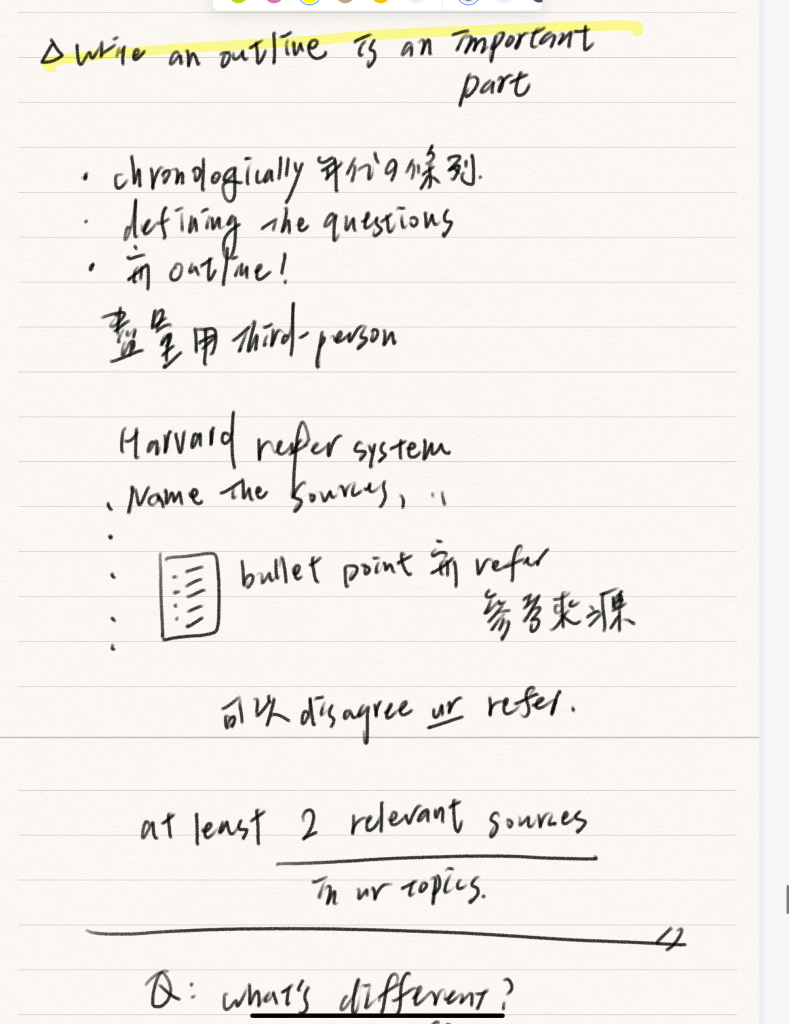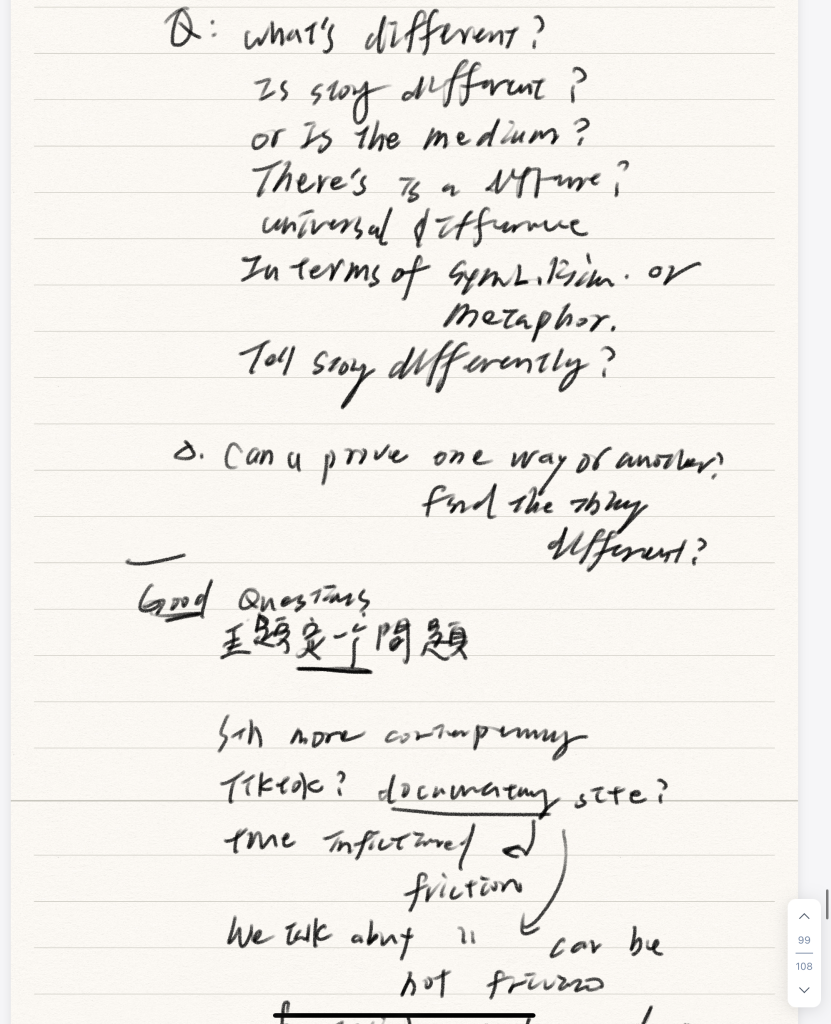Week8
-> 2023 22 Nov.
Defining and Testing a Research Topic
Critical thinking is the active and objective analysis of information, requiring logical reasoning and the ability to question assumptions. It plays a crucial role in problem-solving, decision-making, and understanding complex issues.
Descriptive Writing
This type of writing typically outlines the undertaken tasks, relies heavily on quotations, provides a summary of literary works, compiles lists (of literature, theories, etc.), presents factual information such as measurements or data, narrates the history of an event or idea, offers biographies of significant individuals, and summarizes the existing knowledge on a given topic.
Critical Writing
- Gives a clear and confident account that refuses simply to accept what has been said
- Gives a balanced account of the pros & cons of ideas
- Avoids unsubstantiated assertions – Asserts or assumes something is simply true
- Uses paragraphs to develop and expand ideas
- ALWAYS gives a clear and precise account of the relevant evidence and arguments
- ALWAYS backs up argument with evidence
- ALWAYS gives reasons for conclusion
- ALWAYS recognizes limitations (tends, suggests..)
- ALWAYS avoid simplistic conclusions
Choosing a Critical Report Topic
Selecting a critical report topic involves thoughtful considerations such as personal motivation, potential impacts on theoretical and practical studies, and the ability to fulfill assignment outcomes. It is crucial to identify the audience and purpose of the report, break down the assignment into main questions, and plan the investigation to find answers. The chosen topic, serving as the research question, should connect to the field of art, design, and visual culture, maintaining the student’s interest throughout the research process, while ensuring it is focused, intellectually challenging, and realistically researchable.
Critical Thinking
Good critical thinking is like being a detective. You thoroughly investigate the problem, argue for and against ideas, question the information (like literature), sum up and think about theories, and then make an informed decision based on the evidence.
- It is not just a statement -> need something to prove your words
- Gives a balanced account of the pros and cons of ideas.
- assume something is simply true.
- It can be presumed that it had some potential to be true.
- Always backs up argument with evidence
- Give reasons for the conclusion
Descriptive & Critical Approaches
• Summarize important ideas, books, theories, concepts
• Describe the research method and process
You should include SOME personal reflection:
• Formal tone: third person perspective (“it was found that…”)
• Tentative tone: (“it has been suggested,” “it could..”)

Key:
- Read it
- Understand it
- Your perspective
- Balance
- Writing an outline is important!
Notes


–
My topic on Pedlet:
Exploring the Impact of Motion Graphics on Branding Identity
Nowadays, big brands use motion graphics a lot for their logos, websites, and apps. Since we see ads every day, I’m curious about how animation helps brands stand out. By looking at examples from companies like Apple, Google, and Microsoft, I want to figure out how animated logos make brands more recognizable and tell better stories. It might cover storytelling, storyboarding, the 12 principles of animation ( maybe? ), and its development history.
Keywords:
- Logo Animation
- Motion Graphics
- Storytelling
- Title Animation
- Advertisement
- Storyboard
- Style frame
- Identity
- Visual Communication
- Marketing
Resources:
Book
- Motion Graphic Design and Fine Art Animation : Principles and Practice, by Jon Krasner
- Design for Motion, Fundamentals and Techniques of Motion Design ,by Austin Shaw
- The Theory and Practice of Motion Design: Critical Perspectives and Professional Practice , by R. Brian Stone and Leah Wahlin
- Motion Graphic Design: Applied History and Aesthetics, by Jon Krasner
- Motion Graphics – 100 Design Projects You Can’t Miss ,by Wang Shaoqiang
- Designing Interface Animation: Meaningful Motion for User Experience: Improving the User Experience Through Animation ,by Val Head
Website
- Google.Design
- The School of Motion blog
- The Mighty Fine Advertising Agency Web
- Adobe Website
on Google Scholar ( About 34,900 results )
